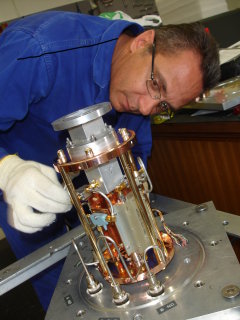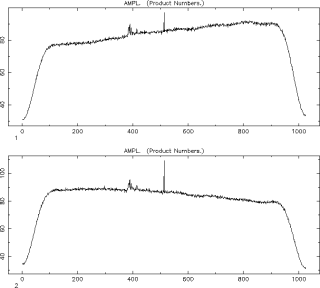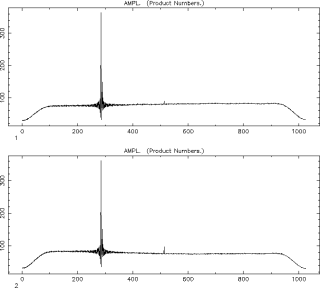
Left click on image for large version.
Technician Jacques Grobler carefully reassembles the 4.5 cm / 6.7 GHz
receiver, 2010 October 19.

HartRAO Home > news > First post-repair astronomical VLBI with Australia 2010/10/26
Dismantling the receiver in the microwave laboratory began on 2010 October 11.

Left click on image for large version.
Technician Jacques Grobler carefully reassembles the 4.5 cm / 6.7 GHz
receiver, 2010 October 19.
The receiver was rebuilt on a new cryogenic expander, the previous one having failed, and minor faults were corrected. The expander ('fridge') cools the low noise amplifiers down to about 15 K (-258 degrees Celcius) in order to lower the thermal noise in the receiver and make it more sensitive.
With a deadline for recommissioning of October 25, in order to participate in a VLBI experiment, work proceeded rapidly.
The receiver was cooled down to cryogenic temperatures for the first time on October 22. The next day VLBI Project Manager Jonathan Quick tested and calibrated the receiver in the laboratory. On the morning of October 25 the receiver was reinstalled on the 26m telescope and cooled down to its operating temperature. The planet Venus provided a bright radio source for Jonathan to test the receiver and measure the feed offsets so that the telescope could be pointed accurately.
That evening the internet connection from HartRAO to Australia broke in Durban, caused an unwelcome hiccup in setting up testing of the receiver for VLBI. However the 'fringe test' to check the receiver was VLBI qualified went ahead successfully anyway, using a 'store and forward' technique.
The main science experiment was to image 6668MHz methanol masers in star-forming regions in the Southern Milky Way using the HartRAO 26m telescope with radio telescopes in Australia. This began on schedule at 07h34 SAST, under Jonathan's watchful eye.

Left click on image for large version.
The HartRAO spectrometer was used to display the receiver passband during
the VLBI. Here the strong methanol maser emission is seen left of centre.
The upper plot shows the left-circularly polarised band,
the lower plot shows the right-circularly polarised band. The spikes in the
centre are instrumental artifacts.

Left click on image for large version.
The following day one of the targets was the brightest 6.7GHz methanol
maser, in G9.62+0.20. This produced the impressive signal seen above. It is
not resolved in this technical monitoring spectrum.
This VLBI was the first astronomical research VLBI with Australia since the repair and recommissioning of the 26m telescope in 2010 July.
The first post-repair VLBI was also with Australia, and had been undertaken on 2010 August 11. In this the (ex-NASA) HartRAO 26m telescope had combined with the University of Tasmania 26m telescope (also ex-NASA) and NASA's DSS-45 34m antenna at Tidbinbilla in the 24-hour long CRF60 astrometric experiment. This was one of a continuing series astrometric VLBIs run by the International VLBI Service for Astrometry and Geodesy (IVS) aimed at establishing, maintaining and improving the International Celestial Reference Frame in the Southern Hemisphere. The ICRF provides the framework for astronomers to accurately locate other celestial objects.